TRADES LANDSCAPE







Feeling cautiously optimistic about 2025? You’re not alone. See the results of our annual reader survey for more trends and insights.
BY KARINA SINCLAIR
CONGRESS 2025
Learn, network and strike a deal at Canada’s premier trade show for landscape professionals.
BY KARINA SINCLAIR
The next generation of landscapers weigh in on their hopes and dreams for the future of the green trades.
BY JULIA HARMSWORTH
How working abroad can transform your landscaping career.
BY ELISSA ASTORINO
CREATIVE DIRECTOR
Mike Wasilewski
MANAGING EDITOR, MULTIMEDIA
Karina Sinclair
ASSISTANT EDITOR
Robert Ellidge
GRAPHIC DESIGN ASSOCIATE
Aisha Shaikh
PROOFREADER
Julia Harmsworth
ACCOUNT MANAGER
Greg Sumsion
ACCOUNT MANAGER
Liz Lant
COMMUNICATIONS COORDINATOR
Angela Lindsay
DIGITAL MARKETING SPECIALIST
Charlotte Guena
ACCOUNTANT
Joe Sabatino
STAFF CONTACT INFO AT LANDSCAPETRADES.COM/CONTACT
ADVISORY COMMITTEE
Gerald Boot CLM, Lindsay Drake Nightingale, Jeremy Feenstra, Mark Fisher, Hank Gelderman CHT, Nick Winkelmolen
Landscape Trades is published by Landscape Ontario Horticultural Trades Association 7856 Fifth Line South, Milton, ON L9T 2X8 comments@landscapetrades.com www.landscapetrades.com
Landscape Trades is published six times a year: February, March, May, August, October and December.

Gratitude, hope and forward thinking drive the landscape profession into the future. BY
KARINA SINCLAIR
Transitioning from owner to observer: How to build a company that runs without you. BY RYAN
MARKEWICH
Examining the state of the landscape design profession. BY PAUL BRYDGES
Box tree moth: Can resistance be bred into boxwood? BY JAMIE AALBERS
specialists.

Fred
50+ YEARS OF THE BEST IN OUTDOOR POWER EQUIPMENT.
ECHO does power your way. Gas Power. Battery power. Super power.
The ECHO Pro-Grade Battery System cuts workdays down to size. MAXOUT® battery technology give 100% power until 0% charge.
So, what’s the best for your workday? Only the best.

FIND YOUR CHOICE OF POWER
BOOTH # 1808

6:00 A.M.
Your 4-person crew arrives to an EnergyCube inside their trailer, along with the two Optimus mowers and 12 handheld batteries, all fully charged. They unplug one charging cable and are ready to start the day with their Optimus equipment by 6:15 AM.

6:00 P.M.
Before heading back to the shop, your crew plugs in the battery filled Caddies and their Optimus Z’s to the EnergyCube. They connect the EnergyCube with a single charge cable, ensuring that all equipment is fully charged and ready for the next day.

12:30 P.M.
During their lunch break and between jobs, all connected equipment is fully charged and the Optimus Z’s are charged to achieve an additional 2 hours of runtime, ensuring they’re ready for the afternoon tasks.


BY KARINA SINCLAIR
AS WE WRAP UP another year, I’m reminded to take stock of everything we’ve accomplished over the past 12 months and look ahead with a blue sky state of mind. Here at Landscape Trades, our editorial team is dedicated to providing readers with both inspiration and practical insights that fuel innovation and growth. Each issue is crafted to explore diverse topics that add value across the green industry — from horticulture therapy and artificial intelligence to road salt remediation and water conservation.

I am endlessly grateful to the people who make our six annual print issues, monthly e-newsletters and social media posts possible. Our talented columnists take time from their successful careers to share their expertise in garden centre management, urban forest technology, legal issues and best practices for small business owners. The landscape pros highlighted in our Mentor Moments are unfailingly humble and generous with their insights. We’re fortunate to work with talented writers who bring us fresh perspectives and deep research. And as managing editor, I’m honoured to work with the unsung heroes of Landscape Trades: Mike Wasilewski, Robert Ellidge, Greg Sumsion, Liz Lant, Angela Lindsay and Charlotte Guena. These talented and dedicated souls never get a byline, but they contribute their hearts and souls to making Landscape Trades the premier horticultural trade publication in Canada. Take a bow, team.
While on the topic of thanks, I’d like to express my appreciation for everyone who participated in our 2024 State of the Industry Survey. Your responses have given us a richer understanding of what’s happening in the green trades across the country. Despite having faced plenty of shared challenges this year, landscapers and horticulturalists are a wary, yet hopeful sort. Flip to page 30 to learn how landscapers like you are facing 2025 with resilience and resolve.
One thing to look forward to in the new year is the Landscape Ontario Congress Trade Show and Conference, taking place Jan. 7-9, 2025. It’s the biggest and longest-
running trade show for landscape professionals in Canada and draws exhibitors and attendees from across North America. Head to page 40 to learn how Congress can provide the boost your business needs. My best advice — wear comfortable shoes. Your feet will thank you as you traverse nearly 10 acres to take advantage of all the learning and networking opportunities Congress has to offer. By the way, there’s still time to register and I’m delighted to offer Landscape Trades readers a VIP code to attend for free: LTMAG2025
Also looking forward, the next generation of landscapers is ready to make a meaningful contribution to the green industry. Julia Harmworth spoke with recent graduates of the Fanshawe College Landscape Technician program to capture their hopes and dreams for the green trades — find their youthful insights on page 46. Meanwhile, recent Niagara Parks School of Horticulture graduate Elissa Astorino shares the lessons she learned working abroad, including her unique experiences landscaping around bush turkeys in Australia. Her experience is documented starting on page 52.
Bush turkeys were not one of the key challenges that came up in our State of the Industry survey results, but you never know what the coming year might bring. As we close out this year, let’s all embrace a blue sky state of mind — looking ahead with optimism, inspired by both the seasoned professionals and emerging talent who make this industry vibrant. Together, we’ll tackle new challenges, explore untapped potential and continue growing a greener future. Here’s to a bright 2025 and the endless possibilities on the horizon.
Until next time,
Managing Editor, Multimedia
We’d love to hear your feedback, story ideas and thoughts for future issues. Reach out to editor@landscapetrades.com (or stop by booth #1528 at Congress) and let’s chat! LT

FRONT MOUNT TRACTORS STAND-ON COMPACT LOADERS MINI EXCAVATORS



From mowers to excavators, UTVs to stand-on compact loaders, and all attachments in between — Kubota provides landscaping equipment built to handle Canadian demands. Our range combines quality performance and lasting durability to deliver professional results. Best of all, we offer competitive commercial financing options and support from our Canada-wide dealer network to maximize productivity and reduce downtime.


Not only do plants beautify indoor spaces, they also reduce stress, filter air pollutants, boost moods and increase creativity — making for a healthier, happier environment for all. Installing and maintaining interior plantscapes for commercial or residential clients requires deep knowledge about soil quality, plant nutrition, light conditions, pests and much more. Landscape Trades asked interior plantscape professionals to share their insights to help dispel the myths surrounding their specialty as they strive to maintain living walls, potted tropicals, seasonal and special event decor or other indoor biophilic features.
common areas can have it, as it is supporting recovery. Bio-field is a part of healing and recovery. I wanted to work was never chosen to be an employee of interior plantscaping and now I can work one day a week to learn and do this.”
intricate part of the interior built help people connect they spend the time inside!
general public knew that industry! I believe that by plants at the shopping mall and janitor looks after aren't real. They years of experience takes to properly indoor gardens an interior plantscape that we put the right spot and care for years in the same does start to decline tired looking, we'll fresh plant at no extra of our guaranteed service. We not only pots and built-in are also taking
advantage of the vertical space by installing living walls and moss art on office and lobby walls.
Caring for interior plantscapes is a rewarding career because you get to look after plants year-round in a climate-controlled environment. We do not have the seasonality inherent to the outdoor companies trying to plant in such a short season. Our plants are available year-round and are mostly imported from Florida with some species coming from Hawaii. We get to nurture the plants and our soul by caring for foliage and flowers.
Some of our challenges are the environmental changes inside while the seasons change outside. For example, in the fall, the heaters in the buildings turn on, creating a very harsh, dry climate for our tropical plants that typically don't do well without humidity in the air. They dry out incredibly fast and are more prone to pests such as spider mites. Then, when the light levels drop in the winter from lack of sunshine, most plants tend to go dormant and can sometimes stop using water at all.

Another challenge is the cold winter air coming into lobbies and vestibules, especially through automatic entrance doors that stay open for a while. The freezing air pours in and can cause cold damage on foliage or, in severe cases, the wind can actually freeze the moisture in the leaves, making them turn black and mushy when they thaw.
Another challenge we are currently facing is access. Ever since the COVID-19 lockdowns, we have had difficulties entering offices. Many of our clients are on part-time remote work from home and, therefore, there is skeleton staff on Mondays and Fridays with Wednesdays being packed with meetings. On the pillar days, we have a hard time getting into the clients' premises at all and in the middle of the week, we can't get into some private offices and meeting rooms where the plants are located.”
- Hella K.

ADVANTAGE FARM EQUIPMENT Wyoming 1-866-713-6656
BOBCAT OF BARRIE Barrie 705-726-2228 www.OakenEquipment.ca
BOBCAT OF BRANTFORD, INC. Brantford 519-752-7900 www.BobcatofBrantford.com
BOBCAT OF DURHAM EAST, LTD. Courtice 905-404-9990 www.BobcatofDurhamEast.com
BOBCAT OF GREY BRUCE Owen Sound 519-372-9100 www.BobcatofTC.com
BOBCAT OF HAMILTON, LTD. Stoney Creek 905-643-3177 www.BobcatofHamilton.com
BOBCAT OF HURON Walton 877-887-6365
BOBCAT OF LONDON, LTD. London 519-455-4900 www.BobcatofLondon.ca
BOBCAT OF MUSKOKA Muskoka 249-390-7000 www.OakenEquipment.ca
BOBCAT OF PARRY SOUND Nobel 705-342-1717 www.BobcatofParrySound.com
BOBCAT OF PETERBOROUGH Peterborough 705-748-9199 www.BobcatofPeterborough.com
BOBCAT OF SAULT STE. MARIE Sault Ste. Marie 705-949-7379 www.Bobcat-ssm.com
BOBCAT OF STRATFORD Stratford 519-393-6040 www.BobcatofStratford.ca
BOBCAT OF THE TRI-CITIES, LTD. Kitchener 519-579-9100 www.BobcatofTC.com
BOBCAT OF WINDSOR Windsor 844-807-0120 www.OakenEquipment.ca
BOBCAT OF TORONTO Brampton 416-679-4172 Scarborough 416-679-4171 www.OakenEquipment.ca
Equipment World Inc. Thunder bay 807-623-9561 www.Bobcat-tbay.com
JOHN'S EQUIPMENT SALES & SERVICE, LTD. Frankford 613-398-6522 www.JohnsEquipmentSales.com

The overdose crisis is one of the most serious public health crises Canada has ever faced, according to a statement by the Honourable Ya’ara Saks, minister of mental health and addictions and associate minister of health on the overdose crisis. Addiction and overdoses impact the trades more than any other profession.
The statement said that between January 2016 and June 2024, “there have been 44,592 opioid-related deaths. Despite ongoing efforts at all levels of government and with partners across the country, 8,049 people lost their lives to opioids in 2023. That's an average of 22 people dying each day.”
Since 2016, 72 per cent of accidental apparent opioid toxicity deaths were male, and 30 to 50 per cent worked in trades at the time of their death. Thirty-one per cent were between the ages of 30 to 39 years. Physically demanding jobs, such as landscape construction, can come with pain, injury and stress. This can lead to using substances like drugs or alcohol to cope. The stigma they face is also great, as men are less likely to talk about
their substance use or mental health challenges for fear of being judged or penalized.
The crisis is driven by a dangerous illegal synthetic drug supply that is unpredictable and increasingly toxic. Powerful drugs like fentanyl, and other emerging synthetic opioids are flooding the illegal drug supply and resulting in an increase in harms and deaths.
Health Canada has re-launched an updated Ease the Burden campaign to offer free resources for men struggling with substance use and to share the message that "it takes strength to ask for help." The campaign also includes information for employers to help start a conversation about substance use and addiction in the workplace. The goal is to create a space where men feel safe and supported to reach out for help if they are struggling with substance use and addiction, to reduce stigma around getting help, and to ultimately save lives.
To learn more and access available resources for workers, employers and others in the trades, please visit Canada.ca/Ease-The-Burden.

Our plants are grown using a combination of the latest greenhouse technologies and IPM methods. Most of our liners are easy to transplant Elle Plugs, while others are traditional loose fill plugs or mesh sleeved Growcoons. The type of plug used is based upon the specific needs of the plant.


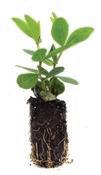






IS DESIGNED TO MAKE LOADING AND UNLOADING ANYTHING FROM THE BACK OF YOUR TRUCK BED BOTH

With dual extension springs to assist with raising and lowering of the ramp, one-man operation is simple, easy and effortless.






PanAmerican Seed was pleased to present a donation check to the National Multiple Sclerosis Society during the organization’s local “Dinner of Champions” event Sept. 13 in Chicago, Ill. The donation was the result of seed sales of the company’s Beacon series of Impatiens walleriana, monetary support through branded apparel sales, as well as participation in BikeMS fundraising.
“Dinner of Champions” is an annual fundraising event of the MS Society that brings together supporters and people living with Multiple Sclerosis. The Chicago event was decorated with Beacon Impatiens tablescapes, and branded signage donated by PanAmerican Seed.
A featured speaker of the event was Todd Frauendorfer, treasurer for Ball Horticultural Company, whose life goal was to drive donations to $1 million over the course of his MS diagnosis. The involvement of Beacon Impatiens in 2024 helped him reach his goal and the milestone was celebrated on stage.
“It was a privilege to be part of such an amazing night and especially to be a part of Todd’s journey all year long,” said Sarah Makiejus, global marketing manager for PanAmerican Seed. “It was a true team effort, and we continue to be pleased with the impact Beacon Impatiens has on the industry, as well as how its annual charitable giving continues to make a difference in so many lives.”

Beacon Impatiens, a series of Impatiens walleriana with proven high resistance to impatiens downy mildew, brings delight back to shade gardens everywhere. As part of a dedicated mission to “shine the light,” PanAmerican Seed has committed to donating to a new charity each year. A new charitable partner will be announced soon for the 2025 sales season.



Platinum Natural Stone specializes in providing high quality Armour Stone for landscaping, retaining walls and shoreline construction projects. Platinum offers a variety of products including: Armour Stone, Flagstone, Weathered Cap Rock, Natural and Saw Cut Steps and Skidded Armour. Platinum is open year round for all your Armour Stone needs. Rain, snow or shine!






The Salvation Army has received a significant equipment donation from Bobcat Company to support ongoing relief efforts in the aftermath of Hurricanes Helene, Milton and beyond. This donation, valued at $885,000 USD, includes 23 essential pieces of equipment, such as forklifts, portable generators and light towers all vital for aiding communities impacted by natural disasters. These assets will be stored at The Salvation Army’s Emergency Disaster Services (EDS) warehouses and deployed across the southeast, ensuring rapid and effective response to both the current and future disasters.
The Salvation Army has often needed
to rent much of this equipment in times of disaster, a costly and logistically challenging necessity, particularly during times of high demand following disasters. With Bobcat’s support, The Salvation Army can respond immediately without needing to source critical equipment during emergencies, enhancing its capacity to serve affected communities effectively.
“This equipment will not only help with our immediate response efforts to Hurricanes Helene and Milton, but will also save valuable time and money responding to future disasters,” said Commissioner Kenneth Hodder, national commander of The Salvation Army. “Service delivery is severely impacted when critical equipment is unavailable during
disaster operations, and this significant addition of operational equipment in our warehouses and the field is essential to ensuring the safety of our workers and in providing crucial services to survivors.”
“Bobcat equipment is often at the forefront of helping communities rebuild after natural disasters,” said Mike Ballweber, president of Doosan Bobcat North America. “Our collaboration with The Salvation Army allows Bobcat and our equipment to make an even greater impact, empowering The Salvation Army to maximize their efforts in doing the most good.”

The world didn’t need a new mower. It needed a new Lazer Z.
The Lazer Z X-Series has arrived—built to deliver unmatched durability, legendary cut quality, and performance that exceeds expectations at every turn. The future of mowing has never looked so good. Visit your dealer to experience the Lazer Z.


Explore the legacy behind the legend.
On Oct. 20, the thirtieth edition of the Communities in Bloom (CiB) National and International Awards Ceremonies was held in Charlottetown, P.E.I., honouring municipalities across Canada, Ireland, Italy, Hungary and the U.S.
Communities in Bloom is a volunteer and partnershipdriven organization that uses a multi-tiered competitive evaluation process to foster community strength, involvement and continuous improvement. This is accomplished by nurturing environmental sustainability, enhancements of green spaces and heritage conservation, in cultural and natural environments encompassing municipal, residential, commercial and institutional spaces.
NATIONAL AND INTERNATIONAL AWARD WINNERS
National Population Town of St. Paul, Alta.
International Challenge (Small) City of Lewes, Delaware, U.S.
International Challenge (Medium) Trim, Meath County Council, Ireland
International Challenge (Large) City of Barrie, Ont.
Class of Champions (Small) Town of Stonewall, Man.
Healthier, Livable Cities: City of Fredericton, N.B.
“On behalf of our national board of directors, our volunteer judges, sponsors and partners, I sincerely thank and congratulate all the communities that have participated in the CiB provincial, national and international programs in this, our thirtieth year,” Susan Ellis, CiB national chairperson, said. “While the past few years have tested our strength and resilience, we have persevered and emerged stronger and more determined in 2024 as participation rates grew by 32 per cent over last year. We have carefully observed the challenges our participating municipalities are facing, and we have responded with a greater emphasis on environmental sustainability as we continue to make our communities greener, healthier and more liveable."
OUTSTANDING ACHIEVEMENT AWARDS AND CONTESTS WINNERS
Teck Community Appearance Award: City of North Bay, Ont.
Canadian Nursery Landscape Association Environmental Action Award City of Coquitlam, B.C.
Communities in Bloom Heritage Conservation Award Town of Devon, Alta.
Communities in Bloom Tree Management Award City of Fredericton, N.B.
Scotts Turf Builder Landscape Award City of Castlegar, B.C.
National Capital Commission Plant & Floral Displays Award City of Fredericton, N.B.
Scotts Youth Involvement Award City of Melfort, Sask.
Scotts Community of Gardeners Award Ville de Rosemère, Que.
Communities in Bloom Community Involvement Award Town of Mahone Bay, N.S.








In 2025, Wave Petunias from PanAmerican Seed will reach an industry milestone celebrating 30 years of petunia gardeners trust. Since its debut in 1995, the brand in its distinctive pink packaging has drawn shoppers and fans by the millions. To commemorate such an important anniversary — and help greenhouses and retailers take advantage of extra consumer interest — PanAmerican Seed announces several exciting plans beginning this spring.
First, the brand now has an official consumer holiday: National Wave Day is May 3. Stay tuned for a list of festivities as the Wave Petunia team counts down to the kickoff of its new holiday celebration.

Next, to further confirm that “Wave Is Growing,” PanAmerican Seed will be unveiling a new addition to its Wave Pansies line.
Top Wave Pansies will debut in California during the annual Spring Trials (CAST) event at the Santa Paula location. Registration will be open soon for members of the industry to get a first look.
To build upon the Wave brand’s vision of colouring the world with flowers through thoughtful and engaging collaboration with trend-setters, tastemakers and creatives, Wave Petunias will be launching an exclusive partnership with a renowned artist who will use Wave Petunias in a very special way to herald new growth, hope and possibility. More details to be revealed in the months to come.
“After 30 years, the Wave brand remains so special to the horticulture industry not only for its pioneering ways, but because it continues to evolve and meet the needs of the new consumer,” says Sarah Makiejus, global marketing manager for PanAmerican
























Seed and the Wave brand manager. “We have an amazing anniversary year planned that will excite the consumer, create a positive buzz around our industry and build business for our PanAmerican Seed customer. I can’t wait for each of these announcements to soar!”
To help greenhouse growers and garden retailers prepare for the increased interest in Wave Petunias and Wave Pansies throughout 2025, a full promotional package was made available free of charge in November. Advanced access to these marketing assets (videos, signage, social media posts, handouts, etc.) will give the industry the tools it needs to plan local and more personal events with the Wave brand.
For best availability of Wave Petunia colours and mixes for this 30th year of celebration, PanAmerican Seed is encouraging greenhouses to contact their preferred supplier for seed and plugs. Another announcement will be forthcoming

on how to participate in the upcoming events, as well as how to register a retail business as a location to purchase Wave
Petunias and Wave Pansies. For more information, please visit panamseed.com.

See your authorized Isuzu dealer for more information.









SingleOps, a leading provider of arbor and landscape business software, recently announced its merger with Landscape Management Network (LMN), the largest provider of landscape business software and crew training in the United States and Canada. Together, they form the premier business management software and payments platform serving the full-service landscaping, tree care, design/build and snow removal industries.
Mark Sedgley, CEO of SingleOps, will lead the combined business effective immediately. Mark Bradley, founder of LMN, will remain with the company as a strategic advisor and partner to the business.
"Merging these two incredible companies allows us to continue putting our customers first," Sedgley said. "Our customers are the fabric of our economy and create millions of jobs all over North America and in their respective communities. Both SingleOps and LMN take this responsibility very seriously, working hard to empower our customers to thrive."
"It has been a great privilege to lead LMN for over 16 years, and I am excited to work closely with SingleOps to create a market-leading business serving the green industry," said Bradley, founder of LMN. "LMN is fortunate to have found a strategic partner with complementary capabilities and a shared vision for growth, and the combined company is now
well-equipped to continue to capitalize on the market opportunity."
The green industry continues to undergo rapid change but remains largely fragmented. Despite the growing need for intuitive business management solutions to improve efficiency, the industry remains early on the adoption curve, with more companies expected to require all-in-one solutions, including payments capabilities, in the coming years. SingleOps and LMN will continue to support and invest in their respective software platforms, aiming to optimize their technology capabilities and expand the breadth of services they provide to meet market demand.
"By bringing together these two leading vertical SaaS platforms, SingleOps and LMN are uniquely positioned to support the full range of customer needs across the green industry," said Robert Anderson, partner at FTV Capital. "LMN and SingleOps have shared cultures of putting their customers first and understanding the pain points from their clients' perspectives. We look forward to supporting the combined company as it continues to help the industry be successful and work tirelessly to serve its great customers."
Sedgley added, "FTV's partnership and expertise have been instrumental to getting us where we are and will be equally as vital as we move forward into this next exciting phase of growth."











Landscape Ontario Congress January 7-9, 2025 at the Toronto Congress Centre Booth 1728 COME VISIT US AT


BY KARINA SINCLAIR
In 2024, landscape professionals faced a range of economic pressures, evolving industry demands and shifting workforce expectations with a cautious but hopeful outlook. The fourth annual State of the Industry survey, conducted by Landscape Trades, captures the perspectives of landscapers and business owners across Canada, highlighting their main concerns, strategies for growth and outlook for the future.
Respondents shared their thoughts on inflation’s impact on costs for materials, labour and equipment, along with staffing challenges and increased competition. Despite the pressures, many are optimistic: over half (52.3%) rated their 2024 financial picture as “moderate,” while 31.2% described it as “strong,” and 8.3% even called it a “record year.” Across companies of all sizes and stages, there is a shared focus on innovation and resilience as they look to 2025. Join us in exploring these insights, revealing trends that may shape the future of landscaping and provide strategies to drive growth in a competitive landscape.
In the 2023 survey, respondents predicted inflation as the top challenge they’d face in 2024 and they were right. Survey participants were asked to select all challenges that applied to them, and more than half cited inflation as their biggest challenge over the past year. The cost of everything — from equipment to fuel, materials to wages — crept higher and higher, eating into profit margins. Recruiting and retaining staff was the second highest rated challenge, with some respondents suggesting the cost of living is driving qualified people (staff and clients) away. Hiring staff beyond the summer season and replacing experienced workers who were retiring was also a challenge for many. Cancelled or reduced project scopes and low sales, possibly due to lower priced competitors, rounded out some core concerns for many. And yet, there were a lucky few who did not experience any challenges.

For the coming year, most respondents anticipate the challenges of 2024 to continue. High inflation remains a constant worry, as does losing sales to lowballing competitors. Many feel enough work is available, but clients may need more education to understand the value of higher prices for quality work. The challenge of finding tradespeople to provide that quality work will certainly continue.
Lower pricing usually comes with less quality, knowledge and service! " "
Almost three quarters of respondents said they raised prices in 2024. Most were moderate increases, with over a third raising their prices by up to five per cent, while only a small portion bumped them by more than 20 per cent. A major reason was to offset the higher cost of materials, but also to attract and keep quality employees by offering them a living wage. A quarter of respondents held steady at last year’s rates for a number of reasons, such as fear of scaring off clients who were also feeling stretched by inflation. Others had already raised prices last year and wanted to wait to see how this impacted their business. A very small percentage actually lowered their prices.

Increased costs of overhead and expenses affecting the bottom line. Also, some of the hourly rates of our longterm clients were too low or below the industry standard — hourly prices did not reflect annual cost of living increases.
Even with an exclusive clientele and a very reputable bond with suppliers there is no support from the government to allow growth.
We have seen the prices from our suppliers still increase every year, as well as shipping costs, and we unfortunately need to pass this on to our customers.
Economy was not good. Didn’t want to turn people off with higher prices.
I expect to raise wages for the 2025 season in order to keep my excellent staff.
"The most interesting trend is I find myself spending more time with clients and educating them about old world craftsmanship using new world construction. They have all been blinded by the 20 television shows that are mostly poor quality. Good from far but far from good. The quality shows are more technical and the general public doesn't watch that."
"Xeriscaping is on the rise in the residential market."
"Clients want larger plants and drought tolerant landscapes."
"More plant diversity, developing more gardens to help pollinators. Gardens that have low water needs."
"The trend away from lawns and more towards different types of ground covers other than grass."
"Have noticed a higher demand for lower budget/ quality work this year. Clients looking for quick & cheapest work. Many are planning to move and not wanting to spend or willing to cut corners to flip a property."
"Still lots of projects out there, just on a smaller scale."
"Projects are getting larger and more complex. Customers want a 'turn key' project from design to installation. I will collaborate more with contractors to offer this seamless transition."
"Autonomous mowers will be a game changer. Using AI for CRM and lead generation will also ramp up quickly in the near future."
In 2024, 53 per cent of respondents said they experienced a labour shortage, between “Somewhat” (47.9%) and “A lot” (5.1%). With so many vacant roles, employers had to get creative to ensure they had enough crew members to meet demand. For some, this meant being more selective and passing on smaller jobs to focus on higher quality projects. For others, it meant promoting employees to more responsible crew lead roles before they were ready. Ease of recruitment also seemed to depend on a business’s reputation within its local community. In addition to word of mouth, posting jobs on premises and offering flexible hours, most landscaping companies turned to general job boards to recruit staff.




Another strategy to address labour gaps would be to make a career in the green trades more attractive. Respondents had a lot to say about this. Some feel there has been a renewed interest in working outdoors in nature, while others expressed strong opinions around work ethic, public perception and shady business practices.

Young people are more attracted to tech/online industries, probably.
Flooded by low wage companies that work under the table … this leaves a sour taste in the general public and craftsmen stay away from very lucrative positions.
Technology is helping the industry, and not in danger of AI replacing jobs. Younger people are looking for a trade and this offers something different every day.
More people see the value in working outdoors/in trades.
Parents do not encourage their children to attend these programs because they are not high wage earning professions. The job is physically demanding and many people do not want to do this type of work. Many existing employees in the industry are aging out and not being replaced.
There is a perception that landscaping is not year round and landscape work is labour intensive. Landscaping is highly competitive, and in our area there are a number of contractors that are undervaluing employees and significantly underbidding work.











Kubota D902 diesel 25hp engine
Hansa TMP pumps
Hydrocontrol valves
Danfoss drives
Aux flow 12 gpm
Lift capacity 1,000 lb
35.4” wide machine
8” wide track
3,390 lb weight & lowest C of G
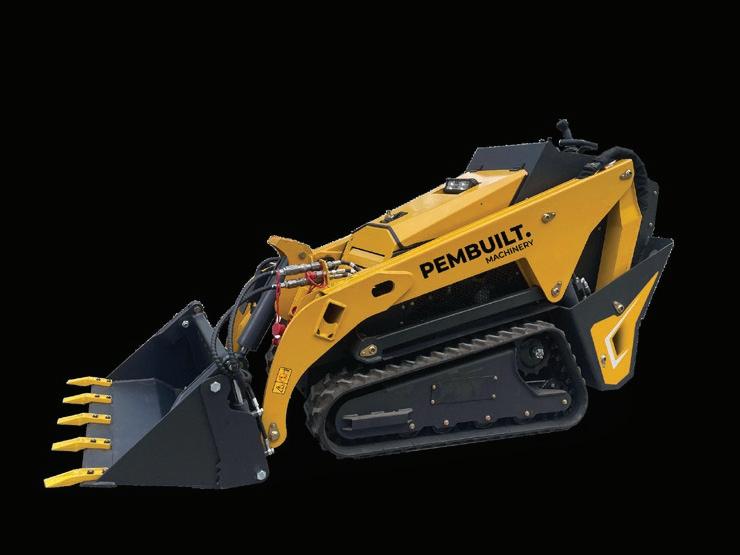
4 in 1 bucket & pallet forks included
2 year parts, 3 year engine warranty







8hr Runtime, 6hr Charge
3 forward, 1 reverse, all variable
Hydraulic dumping
1,100lb load capacity
29” wide
1 year parts warranty

Vertical lift. Loader float function. Costs less than $40k.

Despite the financial challenges of 2024, respondents still expressed optimism about the future of their profession, with very similar results to last year. There’s a lot of hope, albeit tinged with caution. Some of you applaud the younger generation’s commitment to environmental causes, while wondering if they’re ready for the realities of the job site. Many of you have also noticed that clients, especially within the
"I hear it every day from people: ‘If I had to do it all over again, I would’ve gone into the landscape industry,’ or ‘I would love to be working outside every day and then having the winter off to do something different.'
aging demographic, are willing to pay more, whether it’s for higher quality work or to ensure crews enjoy a living wage. Some are worried about land development encroaching on nursery space or fly-by-night businesses tarnishing the reputation of the whole profession, while others are simply delighted to love what they do and would choose to pursue landscaping all over again if given the chance.

We have seen a shift in client values and their desire to pay livable wages for professional service. We are continuing to employ strategies that will educate the workforce regarding careers in the landscape industry. There is a strong market.

The thoughtful responses gathered paint a picture of perseverance. While navigating real challenges, those working in the landscape industry remain cautiously optimistic about the future. Rising costs, labour shortages and increased competition remain common concerns, with many businesses feeling the impact on their bottom lines. However, despite these pressures, most respondents view their current financial outlook as stable, with many expecting moderate growth in the coming year. This careful blend of caution and confidence reflects a resilient mindset across the industry, as landscape professionals prepare to adapt, innovate and seize opportunities in 2025.

*NANOBLAST OPTION ONLY
*NANOBLAST OPTION ONLY
*NANOBLAST OPTION ONLY
The Lyra slab provides both a modern design and a highly detailed surface. Taking advantage of Best Way Stone’s DesignLoc surface refinement technology, Lyra offers a contemporary smooth finish, and is offered in a variety of colours. For a more enhanced finish, Nanoblast colour options are available in this product, providing a fine blasting to the surface, exposing specially selected granite aggregates.
The Lyra slab provides both a modern design and a highly detailed surface. Taking advantage of Best Way Stone’s DesignLoc surface refinement technology, Lyra offers a contemporary smooth finish, and is offered in a variety of colours. For a more enhanced finish, Nanoblast colour options are available in this product, providing a fine blasting to the surface, exposing specially selected granite aggregates.
The Lyra slab provides both a modern design and a highly detailed surface. Taking advantage of Best Way Stone’s DesignLoc surface refinement technology, Lyra offers a contemporary smooth finish, and is offered in a variety of colours. For a more enhanced finish, Nanoblast colour options are available in this product, providing a fine blasting to the surface, exposing specially selected granite aggregates.






























SCAN THE QR CODE TO LEARN MORE ABOUT LYRA


SCAN THE QR CODE TO LEARN MORE ABOUT LYRA
SCAN THE QR CODE TO LEARN MORE ABOUT









F
or landscape business owners looking to grow and stay ahead in a competitive market, attending the Landscape Ontario Congress Trade Show and Conference should be at the top of your 2025 to-do list. Running Jan. 7-9, in Toronto, Ont., this annual event is designed to provide landscaping
professionals with the tools, connections and knowledge needed to strengthen their businesses. Whether you’re looking to expand service offerings, streamline operations or explore new technologies, Congress offers something valuable for every professional and business owner in the industry.
continued >

Many brands launch new products at Congress, so it’s the perfect setting for in-depth research into the latest products, trends and technologies transforming the landscape industry. The event is a unique opportunity for business owners to assess new tools, equipment and software solutions in person. Being able to ask questions directly to manufacturers, test products and explore various options allows for more informed decision-making.
With a newly expanded exhibit floor, you'll have a chance to see the latest innovations up close. If you've been wondering if switching to batterypowered equipment is worth the hype, stop by the new Electric Demo Area to get hands-on experience and ask vendors questions about this new technology.
Furthermore, the trade show enables landscape professionals to learn about design, sustainability and technology innovations that are shaping the future of the industry. This insight can be applied directly to your business, giving you a competitive edge.
One of the most significant benefits of attending Congress is the chance to make deals with suppliers and manufacturers. With over 450 exhibitors, the trade show floor provides access to a wide range of products and services that can help your business improve efficiency and performance. Many exhibitors offer exclusive trade show pricing, which can lead to significant cost savings on everything from equipment and materials to software and business solutions.
More than that, it’s a golden opportunity to develop relationships with suppliers and vendors through face-to-face interactions. These conversations can lead to long-term partnerships that benefit both sides, providing landscapers with more reliable supply chains and favourable terms. For those looking to upgrade equipment, find cost-effective solutions or diversify inventory, Congress is a prime environment for striking deals that can have a direct impact on profitability.

Congress is a hub for the latest ideas, technologies and techniques shaping the future of landscaping, from the increasing focus on sustainable and eco-friendly landscaping practices to advancements in smart technology for irrigation and landscape maintenance. If it’s worth talking about, you’ll find it at Congress.
Attendees have the opportunity to learn about new trends first-hand and understand how these developments can support their operations and client demands. As more clients seek sustainable solutions and innovative designs, being at the forefront of these trends can enhance a company’s reputation and attract new business.
Speaking of education, don’t miss the incredible lineup of expert speakers available at Congress. The LIVE Stage will feature a slate of experienced industry professionals sharing their expertise right on the show floor. These aren’t just people who work in the industry; they’re leaders who have seen and done it all. Be sure to set aside time to attend free presentations on irrigation, hardscaping, lighting, garden centre management and more. Additionally, 18 expert speakers at the Congress Conference (tickets sold separately) will offer insights on the future of the industry, from leadership and nurturing talent to small space and rural property design challenges. When you can speak confidently about upcoming trends, you’ll position yourself as a knowledgeable leader in your market — and that’s something clients love.
Whether you're a small business owner, a seasoned professional or someone looking to grow a larger operation, the education sessions cover practical topics that you can implement right away to see results.
continued >



In the 2024 State of the Industry survey conducted by Landscape Trades (see the rest of the results on page 30), over 62 per cent of respondents said they plan to attend Congress 2025. Read on to learn more about why landscape pros consider this a must-attend event.

Collaboration can often be the key to success. Teaming up with other landscape architects, designers, horticulturists or various sector contractors can help you tackle larger projects, bring new ideas to the table or simply fill in gaps where you don’t have the expertise.
At Congress, you’ll be surrounded by professionals from every sector.

It’s a fantastic opportunity to network, exchange ideas and find potential partners for future projects. Maybe you’ll meet a lighting expert who complements your landscaping skills, or a software developer who has a solution for streamlining your business operations. Congress is also an excellent place to find complementary service providers who can fill gaps in a business’s expertise. For example, educators, marketing professionals, trade associations and other industry-adjacent exhibitors will be there, offering solutions that can address specific operational challenges.
It’s a chance to build a community of trusted contacts who can help you grow your business, share referrals or even just offer advice when you hit a rough patch. Plus, it never hurts to know more people who can recommend you for projects when their own schedules are full.
Running a business is hard work. You’re managing people, processes and client expectations every day, and it can feel difficult to step away from daily operations. Taking a step back to focus on strategy and big-picture planning can pay significant dividends. Congress allows business owners to evaluate your operations, explore new solutions and return to your businesses with fresh ideas and renewed energy.
Being around so many passionate professionals can reignite your own passion for the industry. Hearing from experts and learning about new ideas can inspire you to try something new in your own business. You might leave with fresh ideas on how to market your services, introduce new offerings, support your crew members’ well-being or improve your operations.
Congress gives you the chance to pause, reflect and think about where you want to take your business next. You’ll walk away with new contacts, fresh ideas and the confidence that you’re ready to thrive in the coming year.
For full details on Canada’s largest gathering of landscape and horticulture professionals, visit the event website at LOcongress.com.









BY JULIA HARMSWORTH
illennials and Gen Z are essential to the continuation of the landscape and horticulture trades. Not only are they welcome additions to an industry that needs to grow its workforce, but they also bring new ideas, new skills and a new way of looking at the future.
Landscape Trades spoke to two recent graduates of Fanshawe College’s Horticulture Technician program in London, Ont., to discover what their visions are for the future of the landscape industry and their place within it.
Julissa Litterick is the assistant curator at Fanshawe’s botanic garden. She looks forward to a career in horticulture therapy, drawing on her undergraduate degree in neuroscience, psychology, and nutrition and nutraceutical sciences. After graduating alongside Litterick, Nicolas Prezio started Prezio Plant Art, an exterior maintenance business. He’s also working with Nicola’s Garden Art to launch an interior gardening business focused on tropical planters.
Neither had landscaping or horticulture in their life plans, but a love of the outdoors and a desire to help others brought them to the trades.
continued >


What most excites you about your future career in the green trades?
Litterick: Definitely the public education piece. I love talking to people about plants. I’m also really passionate about accessibility and making landscapes that are not only eco-friendly, but friendly to all types of people and all types of bodies. I enjoy bringing people into a space and helping immerse them in the garden and helping them navigate through the physical barriers that exist in a landscape, and some of that [plant] knowledge as well.
Prezio: With climate change being a really pressing issue, I’m very excited to be part of an industry that’s at the forefront of that topic. When people think of the climate, they think about the gardeners and landscapers, and I think we’re going to play a really important role in that issue. I’m excited about being able to make a change to that going forward.
What concerns you about a future in this industry?
Litterick: The accessibility issue is always a little challenging. Before I started Fanshawe, I got a really bad concussion and still have a bunch of symptoms that make it really hard for me to use a lot of gas- and diesel-powered equipment because of the noise and the vibration. But I’ve found that electrical tools are quite accessible for me — they don’t vibrate as much, and the noise is a lot less. I’m hoping as electric becomes more popular, some of the other parts of the trade that aren’t really possible for me become more accessible. I really do enjoy the equipment side of things — it’s quite confidence-boosting to hold a hedge trimmer in your hand.
Prezio: Climate change, and how that’s going to look for us. Are we going to be

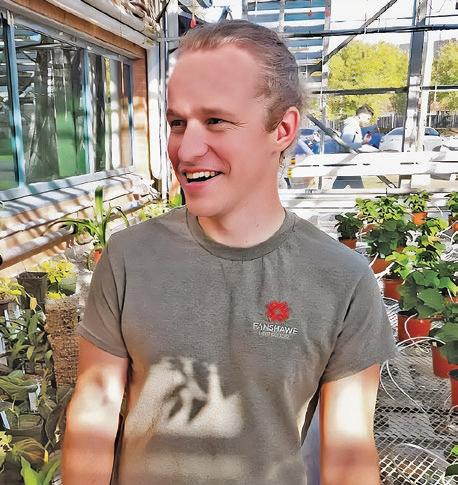
able to plant the same kind of plants that we’re planting now? Are we going to have to change our zones and plant more hot-hardy plants versus cold-hardy? There’s a lot of invasive plants coming in now because our zones are changing, so will our native plants be outcompeted and go extinct? I’m pretty worried about that.
Another thing I’ve noticed is the industry has a lot of problems with sexism. One of my clients has expressed that she feels like when she’s dealing with people from our industry, they overlook her and go towards her husband for answers, even though she’s
the one who has control over the garden scaping. And I’ve noticed in the industry that women are often overlooked or made to feel like they’re not going to do a good job in a certain role even though they’re completely qualified for it. Hopefully going forward into my generation, that is something that improves over time, but it’s definitely worrying to see.
What do you think the trades should do to combat these issues?
Litterick: I’m hoping that we can move towards creating landscapes that can welcome everyone into them. Accessible pavers, guided tours and having those resources available to people who maybe can’t move through a garden space because they have mobility issues — that is something that we should be doing. No one should be barred from having access to nature. At the same time, we need to make accessible options that are also sustainable. How do we make a pathway that someone can move down without hurting themselves without paving over our forests? I’m hoping to see more intersections between engineering and the trade to move forward there.
Prezio: We need to focus more on planting native plants that belong in the landscape, and planting plants in the right spaces where they won’t need extra water or supplemental lighting. I think we need to focus on recycling — investing in pots that can be recycled. Right now, most of our pots end up in landfills, and I don’t think that’s right.
Looking ahead to 2050, what is your vision for the future of the green trades?
Litterick: I would like to see more diversity in the trade. It’s happening — there are people like me who have
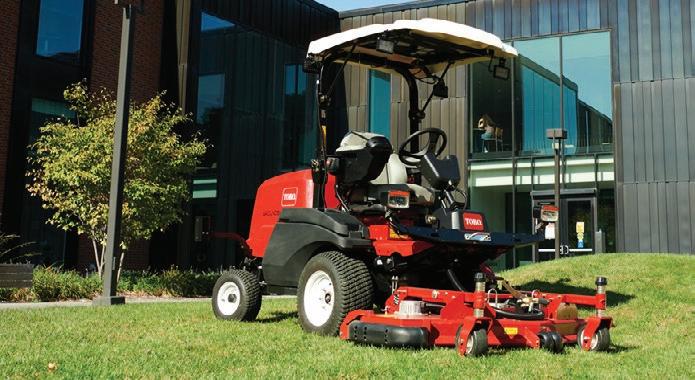








Pam Cook is an instructor, mentor and account manager at Clintar Commercial Outdoor Services in London, Ont. She taught Litterick and Prezio at Fanshawe. Landscape Trades asked her what she makes of the new generation of green professionals.
Tell me about the new generation of landscape and horticulture professionals. How do you feel about leaving the industry in their hands?
I am super excited for them to take over the world. They’re so driven, they are so excited and they come to the table with a new set of values and understandings not just about our industry, but about the world around us. If we’re talking about making sure that we’re being sustainable and preventing climate change, the next level of professionals come with these sets of skills ingrained in them, which is pretty amazing.

What do you think the profession can do to attract and retain younger staff?
A lot of it is understanding that the labour market is not what it used to be. When we were looking at the labour market in the early 2000s, it really was an employer’s market. You could pick and choose who works for you. Now, it really is an employees’ market. Financial ramifications are not the only thing driving this next generation. They want quality of life, they want opportunity, they want additional training and leadership, they want mentorship. They want to be seen as an equal instead of a labourer.
disabilities who are coming into the trade, and there are more women joining all the time, but it would be lovely to see a lot more people of colour welcomed into this space. Folks from different backgrounds have a wealth of knowledge to bring.
I would also love to see a lot more collaboration with Indigenous leaders. They’re the ones who are caring for the land — we should be listening to them and partnering with them. You can’t beat thousands of years of experience. It’s cool to see people talking about the Three Sisters method and how different ways of polyculture and growing can benefit the planet.
Prezio: Definitely one that’s equal for all people, and very easily accessible to anybody. I think anybody should be able to go to school and become a gardener. I don’t think there should be any barriers.
I also think that we should be the loudest voices when it comes to sustainability issues. We can’t hide from climate change anymore or stay quiet about it. We need to be very vocal about what we should be doing, because we are the green industry. I hope the idea of having a perfectly manicured lawn and garden is gone in 10 or 20 years, and is replaced with more biologically diverse landscapes that invite nature back into our suburbs. LT






BY ELISSA ASTORINO

s a recent graduate of the Niagara Parks School of Horticulture, I’ve always been captivated by the beauty of plant life and well-designed gardens. My journey took an exciting turn when I accepted an incredible opportunity to work in Australia, immersing myself in a world of diverse horticultural practices. Working with renowned firms like Yards in Brisbane and Semken Landscaping in Melbourne, I participated in a variety of high-end residential and commercial projects that had me thinking about landscape design in whole new ways.
By gaining international experience, I’ve developed new insights on challenges that are unique to Australian climates, observed emerging trends, learned new techniques and vastly expanded my horticultural knowledge. In this article, I’ll share my reflections on how working abroad can inspire new perspectives and develop a richer skill set.
One of the most rewarding aspects of working abroad was the chance to deepen my understanding of plant species that are less common in Ontario, particularly tropical and subtropical varieties. During my time with Yards in Brisbane, I was privileged to maintain high-end gardens showcasing various styles, including tropical, coastal, rainforest and Australian native gardens. These unique experiences allowed me to see the full potential of tropical plants when grown outdoors, as opposed to their more limited life as houseplants in colder climates.
Working with these plants taught me not only their aesthetic qualities but also their specific cultural requirements. I learned the optimal times and techniques for pruning, how to identify different species and the best ways to care for them in a variety of conditions. For example, I became adept at recognizing which plants thrived in the humid Brisbane climate, understanding the importance of soil composition and how to adjust maintenance routines accordingly. From a design perspective, I learned that some plants such as Thaumatophyllum xanadu tend to stain hardscape surfaces, so they should not be planted along walkways and driveways. Additionally, plant selection such as cacti or thorny shrubs can effectively enhance security while contributing to an attractive garden aesthetic. These plants serve as natural deterrents, creating a lush boundary without the harsh look of steel fencing. By strategically placing them along property lines, you can achieve a beautiful yet functional landscape that combines safety and style. I can apply these lessons to my career in Canada when designing and maintaining gardens.
continued >




In challenging coastal gardens, I saw firsthand the importance of selecting the right plant for the right environment. In this case, that meant choosing plants for their tolerance to both wind and salt spray. This knowledge expanded my plant palette and provided me with the skills to design resilient landscapes that can withstand the challenges of their surroundings.
One of my favourite projects involved a rainforest garden that presented unique challenges. Here, I encountered various pests, such as bush turkeys, which are notorious for digging through gardens to create nesting mounds. To address this, we strategically placed rocks and wire mesh along pathways. This experience taught me not only about pest management but also about the interplay between native wildlife and garden design. While I encountered more familiar pests like aphids and scale, the methods for controlling them differed due to varying regulations. In Australia, regulations regarding pesticides and herbicides are generally less strict than in Canada, which presents both opportunities and challenges. I’ve learned to adapt pest management strategies to comply with local practices while still maintaining a commitment to environmental responsibility by using more organic treatments.
Another aspect of my time in Australia has been the opportunity to work with a variety of materials used in landscaping. In Brisbane, sandstone is a popular choice for hardscaping, primarily due to its abundance. Its natural beauty makes it an ideal option for pathways, retaining walls and decorative features. On the other hand, in Melbourne, I encountered bluestone, which is a textured volcanic rock commonly used in gardens. Understanding these regional differences in materials has broadened my perspective on design options and aesthetics. For example, the choice of stone can significantly impact the overall
look and feel of a garden, influencing how it compliments the surrounding environment. When designing gardens, it’s important to incorporate materials that align with the garden's theme while being locally sourced. Using native materials not only enhances the aesthetic but also promotes sustainability and helps the garden harmonize with its surroundings.
Through my work in various gardens across Australia, I observed emerging trends that differed from those typically seen in Ontario. The extended warm season in Brisbane has led to the popularity of outdoor living spaces. It is common to see not only barbeque areas but also fully equipped outdoor kitchens and living areas designed for entertaining and relaxing with family and friends. This emphasis on outdoor living reflects an appreciation for the natural environment and an inclination to blur the lines between indoor and outdoor spaces. While Canada has a colder climate, I believe the trend of outdoor living can still be embraced. Natural swim ponds can serve as refreshing spots for swimming and enjoying warm summer days, while in winter, they can transform into beautiful ice-skating rinks.
The demand for pools in warmer climates also requires distinct fencing regulations. In Australia, a dedicated fence surrounding the pool area is typically required — even if there is already a perimeter fence around the property. This enhances safety, particularly for young children. To maintain a sense of openness and allow an unobstructed view of the pool area, I’ve noticed many Australian pool fences are made of glass.
I’ve also witnessed a trend toward higher front yard fences and enhanced privacy. In contrast to the open front yards in Canadian suburbs, many homes in Brisbane and Melbourne feature tall privacy fencing or dense hedges, providing a sense of security. This shift in design reflects a growing desire for private outdoor retreats.



My experiences in Australia have been truly rewarding. As I reflect on my time there, I feel grateful for the opportunities I’ve had to learn and grow. Collaborating with companies like Yards and Semken Landscaping has shown me the importance of working alongside passionate teams who are eager to share their expertise and love for the industry. Not only did I learn from those I worked with, but I also had the opportunity to share my experiences and knowledge from Canada. It’s rewarding to both learn from others and provide insight into the different styles and methods of gardening from my home country.
Although Canada has a colder climate, knowledge of tropical and subtropical plants remains important in the horticulture industry. We frequently encounter tropical plantings in shopping centres, offices and indoor gardens. By working directly with these plants in their natural environments, I can apply what I’ve learned to effectively design and maintain these indoor spaces.
I strongly recommend seeking opportunities to work abroad to fellow landscapers, whether you're involved in construction, groundskeeping, design or another area of the green industry. The world is so diverse, and there is much to gain from immersing yourself in different cultures and ways of living. LT










BY RYAN MARKEWICH
Landscaping over 30 years ago, my vision wasn’t fully formed. Like many entrepreneurs, I was driven by the common desire to pay my bills, but I also had a strong desire to build something meaningful that I could be proud of. It wasn’t until much later that I realized the true product of my business wasn’t just beautiful landscapes — it was the company itself.
That realization laid the groundwork for my eventual exit from Creative Roots' day-to-day operations. Today, the company thrives under the ownership of some of the employees who helped build it, along with the rest of the team who continue to drive its success. But getting here was far from easy. It took years of personal growth, plenty of self-inflicted hard lessons and a shift in mindset, especially around the role of people in driving success.
Let’s be clear: setting up an effective succession plan isn’t a one-time event or a simple transaction. It’s an ongoing process that ensures the company’s legacy extends well beyond the current leadership. Over the years, I had to ask myself tough questions: What was I really building? Why would anyone want to own a piece, and what would my company look like without me in the driver’s seat? And, more importantly, how could we create a company that didn’t rely on any one person, but instead had a system in place to thrive under the stewardship of future generations of employees?
The answers didn’t come overnight. In fact, much of my thinking shifted when I embraced The Great Game of Business (GGOB), an open-book management system designed to teach employees to think and act like owners. It was 18 years ago when

we first implemented this game-changing methodology. The idea that “The Company is the Product” resonated deeply with me. This meant our focus shouldn’t just be on creating outstanding landscapes; it should be on building an exceptional company that could sustain itself and thrive beyond any one person — especially me.
Adopting and then adapting GGOB was not a simple task. It required a significant mindset shift from traditional top-down management to a collaborative, transparent process where everyone was involved. The philosophy hinges on teaching people to understand the financials and strategic goals of the business, including every aspect of our operations, from revenue to profits to challenges. We had to trust that our employees could not only understand the numbers but also make decisions based on them.
The level of trust and the quality of engagement that continues to emerge from
our employees has been remarkable. This goes beyond just their day-to-day tasks. Employees are now actively contributing to the development of our career path passport, providing valuable input on sales strategies, financial planning and regularly reporting on key metrics. By involving them in these higher-level decisions, it became clear that we had been sitting on a gold mine of intellectual capital.
In the past, we’d missed out on leveraging these insights simply because we weren’t giving staff the opportunity to contribute. But once we started teaching and including them in management decisions, it was 100 per cent evident that their involvement brought new energy and ideas to the table.
One of the most surprising benefits of transitioning to this new way of operating was the relief I felt as a business owner. For years, I carried the weight of decision making — it felt like the company’s whole

success rested on my shoulders. That burden finally began to lift as we embraced transparency and trust, allowing our team to take on more responsibility.
A perfect example of this shift was with sales. For the longest time, I handled all client interactions, project quotes and
contract negotiations. It was exhausting, and to be honest, I wasn’t doing the best job of it. I needed to step back. That’s when I started involving my installation lead in client meetings. Initially, he would just listen, and afterward, we’d debrief so he could understand the nuances of client interactions.

I also assigned him some basic reading on selling to help sharpen his approach.
Over time, I began asking for his opinion during meetings, and he’d contribute more and more. The process was gradual, but it built his confidence and skills as our roles reversed.
I haven’t been on a sales call in about eight years now, and the projects he handles range anywhere from $150,000 to $750,000.
The same process happened with other parts of the business. Events, team development and even strategic decisions — the team began stepping up, freeing me from the constant stress of sole decision-maker.
The notion that "The Company is the Product" became key as we moved closer to a succession plan. Our crews have been delivering stunning landscapes for years, but now our focus has shifted to the product that could outlast me — the business itself. Because employees had been involved in every aspect of the business for years, they were prepared to step up.
At the core of this transition is one simple truth: people want to win. They want to be part of something bigger than themselves. This belief has been validated time and again. That desire to win, coupled with a clear process, is what allowed me to step back and trust that the company would continue to thrive. I’ve sold 85 per cent of the company to deserving employees, and they’ve carried on with the same commitment to excellence that has always defined our work.
Succession is more than just an exit strategy; it’s about leaving behind a culture of trust, empowerment and belief in the people who make your company what it is. And in the end, that’s the most important product of all. LT

RYAN MARKEWICH has been fascinated by business since starting Creative Roots Landscaping in 1994. After selling a majority of his successful company to key employees, he launched Rmark, a coaching service to help other business owners achieve better results, have more time for themselves and find enjoyment along the way.







































BY PAUL BRYDGES
IF THE 2020s have taught us anything so far, it is that nothing is as expected anymore and that we have to be adaptive and reactive in business. After coming through the busiest few years the horticulture sector has ever experienced, 2024 has proven to be slower than normal. The pandemic did allow companies to grow and thus be able to complete more work than previous years, but this season’s slowdown is more than being able to handle more volume — there is simply substantially less work being priced and completed.


In some cases, this is not necessarily a bad thing. Many business owners are still feeling the fatigue of what felt like a three-year rush with no breaks during the pandemic. Also, the chronic shortage of qualified staff is the perennial issue for our sector. Taking time to conduct additional training for new staff hired during the rush, as well as implementing more efficient processes, will allow us to tighten our belts, which will hopefully keep new employees busy enough to develop into long-term assets to the company.
An incredible number of new companies
have popped up in the last few years with the huge boom seen in the horticultural sector. Unfortunately, without the strong client network and brand recognition of more established firms, this slowdown will likely have a harsher effect on these new companies. Other slowdowns have shown us that some more established firms regain some great team members as the smaller young companies can’t keep their employees busy enough to keep them on. While this is a neutral equation, it shows us how deeply connected we all are in our respective marketplaces. Returning staff


Audio and visual alerts for risky driving events




who wanted to see if the grass is greener elsewhere often come back with a renewed sense of value for the firm they are returning to.
Speaking of networks, it is during the slow times that networks are the most important. It is tempting to find work outside of typical scope to keep crews busy, but this rarely transfers into profitable work. In a stable network you can find work inside your scope or bring in project partners and earn small profit margins in project management. This keeps everyone busy, while ensuring everyone is working within their lane for quality and profitability.
As the construction season for 2024 draws to a close, it is an excellent time to prepare for 2025 and spring construction. Design continues throughout the year; if designers are not busy with projects, that likely means there is less work coming down the pipeline. There are very few projects of any consequence that do not require permits in today’s market, which typically means drawings must be created.
Also, as we continue to see more infill projects within municipalities, the need for proper grading, drainage plans and construction has proven to be a key piece of work that more designers are seeing brought to their studios. Massive rainfall events are becoming the norm; with more hard surfaces being installed within every development, the need for proper grading is key. This is also an incredible opportunity for low-impact design technologies, such as permeable paving, rainwater harvesting and soakaway pits. Incentives for some of these
measures are starting to be put in place by municipalities so developers are more willing to look at incorporating these possibilities.
As the Canadian Nursery Landscape Association (CNLA) and its provincial partners continue to seek grants and support from government programs, it is slowly becoming understood that horticulture is one of the key solutions to mitigate climate change. The dedicated advocacy efforts by the professional members of the CNLA board, staff and committees has advanced the discussion and awareness of our influence at all levels of government.
Congress 2025 will showcase many innovative products and technologies for designers to explore, as well as provide a venue for our community to compare notes and celebrate our associations’ successes of 2024.
So while 2024 may not have felt like a banner year for some, we are all building up for continued success as we move into 2025. LT















Tuesday January 7, 2025
DELTA HOTEL TORONTO AIRPORT 655 Dixon Road, Toronto, Ontario M9W 1J3
RECEPTION 5 P.M. CEREMONY 6 P.M.
INDIVIDUAL TICKET $100 (+HST) TABLE OF 10 $900 (+HST)
Access to the Reception and Awards of Excellence Ceremony. Companies who entered the Awards program will be entitled to two complimentary tickets and will be contacted directly. Winning plaques can be picked up at ceremony. Unclaimed plaques will be sent to Landscape Ontario head o ice for pick up.




CONTRIBUTING PARTNERS

be bred into boxwood?
BY JAMIE AALBERS, Growers Manager, CNLA

PESTS AND DISEASES continually challenge all of us when growing and maintaining ornamental plants, whether we are growing them in our nursery or in our landscapes. Boxwood, or Buxus,
species are no exception. When boxwood blight was first reported in Europe in the early 1990s, selection and breeding programs were initiated to identify and develop plants resistant to boxwood blight. Although it
took significant time and dedication, four Better Boxwood varieties that exhibit boxwood blight resistance have recently been introduced. With the introduction and spread of box tree moth (BTM) into Europe and North

America, it seems natural that breeding programs will shift to focus on developing boxwood varieties that exhibit resistance to box tree moth.
CNLA’s New Plant Development Committee (NPDC) has had multiple discussions on this topic over the past couple of years and contracted Dr. Daryl Somers this past spring to conduct a literature review on the topic of breeding BTM resistant boxwood. The committee was interested in the feasibility of using genetic modification to insert the Bacillus thuringiensis (Bt) toxin gene into the boxwood genome as one method for resistance breeding and asked that the process be investigated and outlined in the report.
Historically, Buxus breeding has relied on chance seedlings and sport mutations to derive new varieties, or relied on open pollination of Buxus collections to generate seedlings. Sheridan Nurseries introduced three varieties in the early to mid 1970s (Green Gem, Green Mountain and Green Velvet) which were interspecific hybrids of B. sempervirens x B. microphylla var. Koreana. B. sempervirens is native to Europe, northwest Africa and southwest Asia while B. microphylla is native to Japan and Korea.
The Sheridan varieties are grown extensively here in Canada, as they are some of the few varieties in the market that combine winter hardiness with the valuable aesthetic ornamental traits.
Currently there are three Buxus breeding programs of note: Herplant in Belgium (Better Buxus), Saunders Genetics in Virginia (NewGen) and USDA-ARS program at the national arboretum in Beltsville, Maryland.
Dr. Didier Hermans of Herplant began breeding Buxus in 2007. They have bred a large collection of hybrids that are interspecific crosses between B. sempirvirens and different B. microphylla subspecies of Asian origin.
Although not breeding specifically for BTM resistance, Herplant tested several Buxus genotypes for BTM resistance which included the four boxwood-blightresistant varieties: Renaissance, Skylight, Heritage and Babylon Beauty. Once BTM larvae developed into caterpillars on the plants, they were able to determine the percentage of dead versus live caterpillars. The new varieties showed a remarkably high percentage of caterpillar mortality whereas B. sempirvirens remained a good food source for caterpillars. These tests concluded that
Asian Buxus species and the four hybrid varieties:
1) showed less pupae forming, 2) showed a high number of dead caterpillars and 3) remained relatively green in field tests under BTM pressure.
Since they were not directly breeding for BTM resistance, these results were simply a side effect of using Asian species in their hybrid development and selecting hard for blight resistance. Similarly, the use of Asian boxwood parentage in the Saunders program is present with the intent to develop resistance to both BTM and blight. The USDA program was not working on BTM resistance and is focused heavily on blight resistance and other performance features. However, they have recruited a Post Doctoral researcher to begin work on genetic modification for BTM resistance.
The obvious modification would be to add the Bt toxin expression into Buxus that would provide resistance to BTM just as the Bt spray does. Genetic modification involves the insertion of a specific DNA sequence












(a gene) into the cells of the receptor plant to introduce the expression of that gene and thus change the traits of the plant. In regard to BTM resistance in Buxus, one could imagine introducing the gene for Bt toxin into Buxus and have Bt toxin expressed to eliminate BTM larvae.
First, the receptor plant should be amenable to tissue culture and in vitro propagation methods. The second step is introducing the gene sequence typically via agrobacterium infection or particle bombardment. Particle bombardment is coating microscopic gold particles with the gene sequence and ‘shooting’ the particles at the tissue to be modified. Finally, the sections of the cultured tissues or single cells that have stably incorporated the gene into their genome would need to be amplified. This involves in vitro growth followed by conversion into plantlets with roots/shoots using various hormone treatments that could then be transplanted to soil and eventually clonally propagated by cuttings. These cuttings would then be grown into plants that could be lab and field tested for BTM resistance.
As can be seen, classical breeding or genetic modification will be a slow process. Is it worth the commitment and effort, and who will invest the resources into this long-term project? As mentioned, CNLA’s NPDC is currently having those discussions based on Dr. Somer’s review and further investigations with other tissue culture labs and breeders. It’s likely others are having similar conversations.
If you are interested in reading Dr. Somer’s full report, please email jamie@cnla-acpp.ca to receive a copy. LT

JAMIE AALBERS
is the Grower & Research Specialist at the Canadian Nursery Landscape Association and has an extensive background in the ornamental horticulture sector as a grower, minirose breeder, research director, trials manager and consultant.
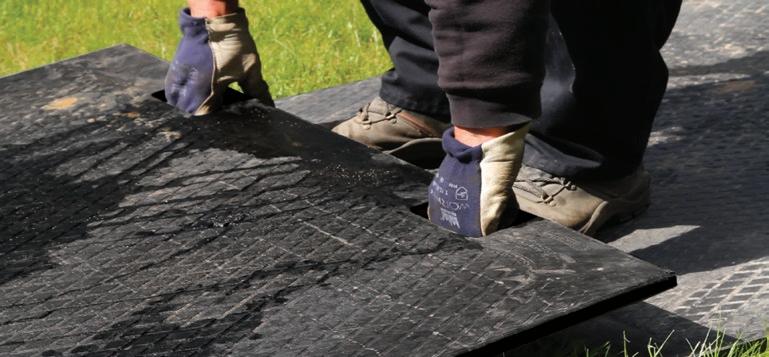




Why soil is essential to Canada’s economic, environmental, human and social health
BY JAMIE AALBERS, Growers Manager, CNLA

The Standing Senate Committee on Agriculture and Forestry recently completed a study on the status of soil health in Canada. The committee learned that soil delivers ecosystem services that enable all life on Earth. Ecosystem services such as water purification and storage; climate and
flood regulation; nutrient cycling; carbon sequestration; the provision of food, fibre, fuel and construction materials; habitats for organisms; and the foundation for human infrastructure and cultural heritage.
Since the last Canadian report on this topic in 1984, soil management has
improved and crop yields have increased with enhanced plant genetics and cultural practices, but these gains have masked the effect of continued soil degradation and loss of agricultural land in every region in Canada. This is a result of climate change and more frequent extreme weather events,

®
urbanization and misread outcomes of soil management practices.
There is no overarching federal strategy currently in place to protect and conserve agricultural and forestry soils in this country. To protect and conserve farmland soil throughout Canada, the committee heard that all levels of government should work together to plan agriculture into, and not out of, communities. Farms cover 62.2 million hectares, or 6.2 per cent of Canada’s total land base. The vastness of our country suggests an abundance of soil, yet only 6.7 per cent of Canada’s land is suitable for agricultural use.
On Feb. 13, 2024, Alan White, vice president and climate change adaptation chair of CNLA, and Phil Paxton, past president of the Canadian Ornamental Horticulture Alliance, were invited as witnesses to the Senate committee. They shared insights on soil health from an ornamental horticulture perspective. All prior witnesses provided insights into
agricultural, forest soils and northern peat soils. Although Paxton provided input on how nurseries manage soil health, most of their responses focused on the importance healthy urban soils play in climate adaptation and mitigation.
Because of the importance of having green spaces to provide the ecosystem services critical to the 80 per cent of Canadians who live in urban areas, the health of urban soils must be considered too. Cities are not “natural” spaces and as such are not conducive to natural plant and forest growth. The dry, compacted soils needed to support buildings and roadways cannot support plant life. Urban green spaces, green infrastructure, and lawns and gardens cannot thrive and grow without healthy urban soils, but often the health of soils re-introduced into newly built areas is an afterthought. Urban soils require the same pre-planting planning that growers use — invest in the soil first, before even considering planting nursery stock or turf.
Soil degradation, which is a usual outcome of modern development practices, prevents soils themselves from providing ecosystem services, but also discourages successful green space plantings and their subsequent contributions too. The first approach to protect and enhance soil health is to minimize threats to degradation; the second is to adopt practices that build or maintain soil health.
White and Paxton provided a few suggestions to the committee. In the Canadian Landscape Standard (CLS), soil was deemed so important to transplant success that a recent investment with Vineland Research and Innovation Centre resulted in a rewrite and update of Section 5 Growing Medium. All municipalities should have a copy of the CLS on hand to support those responsible for managing soil and plantings in cities.
The second suggestion to the committee was to stop replacing green with grey.
continued >






Trees and plants capture carbon, but healthy soils capture even more and healthy trees and plants only thrive in healthy soils. Grey infrastructure removes the ability of cities to sequester carbon. Thirdly, topsoil must have certain standards to sustain life, standards such as amounts of organic matter, porosity, salts and pH. Agreeing on the right standards for soils used in urban plantings and putting them into regulations would ensure all urban landscapes set off on the right footing. And finally, offering tax credits to Canadians for improving their own soil and landscapes would lead to substantial climate mitigation and adaptation improvements occurring at the grassroots level.
Governments also need to take into consideration the role of plants in improving soil health. Trees, plants and grasses are nature-based solutions to rehabilitating contaminated soils. One of the recommendations in the report is that the Government of Canada collaborate

with provinces, territories and Indigenous governments to develop a national strategy for remediating contaminated soils throughout the country.
In healthy urban soils, trees, plants and grasses can fully deliver the environmental, social and health benefits critical to enjoying
At SMS Equipment, we’re more than machines from trusted brands like Takeuchi, BOMAG, and NPK. We provide a complete line of equipment with fullservice product support and manufacturer-backed warranty programs.
Because the right partnership makes everything possible
life in the urban ecosystem. And only in healthy nursery soils can those trees, plants and grasses get a healthy and vigorous start. The full report, which outlines 25 recommendations to protect soils in Canada, can be found online at sencanada.ca followed by a search for “Critical Ground.”

Alan White, Canadian Nursery Landscape Association (CNLA) vice president and climate change adaptation chair, recently represented the industry at the United Nations’ sixteenth meeting of the Conference of the Parties (COP16) Convention on Biodiversity in Cali, Colombia from Oct. 21 to Nov. 1. This was the second Convention on Biodiversity CNLA has attended; the first was in Montreal in 2022 as a guest of the International Association of Horticultural Producers (AIPH). CNLA is honoured to have once again received observer status for this multi-day event.
On Oct. 23, White participated in a panel discussion and shared a snapshot of work being accomplished by the CNLA and the Green Cities Foundation, including the Clean Air Calculator. Led by AIPH, the session, titled "Transformations leading to the ideal

city state for a green future," included Audrey Timm from AIPH, Bruno Marques from the International Federation of
Landscape Architects, Dr. Siobhan McQuaid from GoNaturePositive!, and Professor Harriet Bulkeley from Durham University.






BY STUART SERVICE, Media Coordinator, CNLA
The thirtieth edition of Communities in Bloom’s National Symposium and Awards ceremonies brought 147 delegates from more than 40 communities across Canada and


worldwide to Charlottetown, P.E.I., from Oct. 17-20. Members from East Coast Art Party worked on a beautiful, flowery chalk art display outside the waterfront Delta Hotels


Prince Edward, finishing just in time for the opening reception where delegates connected with familiar faces and new friends.
On the morning of Oct. 18, insightful keynote speakers from the City of Charlottetown addressed the audience. Simon Wilmot highlighted restoring urban forests after post-tropical storm Fiona in 2022. The morning finished with a panel led by Katrina Cristall on building a resilient local food system.
Various municipal- and community-led projects were featured during four technical tour stops in and around Charlottetown. Delegates visited the MacPhail Woods Ecological Forestry Project and Native Plant Nursery, delving into inspiring work in forest stewardship, wildlife enhancement and watershed protection. The next stop at the Farm Centre Legacy Garden showcased the power of sustainable agriculture and local food production. The group then visited a net-zero City of Charlottetown building powered by geothermal heating and rooftop solar panels. The technical tour concluded at Wright's Creek Watershed and Andrew's Pond, a peaceful walk highlighting ongoing efforts to conserve and enhance wildlife habitats within city limits.
The busy day was capped with the Community Showcase at the PEI Brewing Company, which honoured the hard work and dedication of the Communities in Bloom participants in the Atlantic Edition, National Edition and International Challenge.
October 19 began with keynote speaker Steve Bellamy sharing details about upgrades to the cultural hub that is the South Pavilion at the Confederation Centre of the Arts. Surprise special guest P.E.I. Senator Mary Robinson introduced a panel discussion about the techniques and benefits of gardening with native species.
The surprises continued while CiB delegates were led on a walking tour of the beautiful art installations throughout Charlottetown. They were treated to performance art at Victoria Row with a flash mob by Thriller P.E.I., who performed the choreography to the 1982 anthem to raise money for local food banks.
The night concluded with the Atlantic, National and International Awards Ceremony Gala honouring the dedication and achievements of communities from across Canada, Ireland, Italy, Hungary and the U.S.
“On behalf of our national Board of Directors, our volunteer judges, sponsors and partners, I sincerely thank and congratulate all the communities that have participated in the CiB provincial, national and international programs in this, our 30th year,” said CiB national chair Susan Ellis.
Next year’s CiB Symposium will take place Oct. 16-19 in Stratford, Ont.

BY STUART SERVICE, Media Coordinator, CNLA
Volunteers from the Hamilton Naturalists’ Club (HNC) have spent the last few years combing through the seven-acre Rolston Community Forest, manually removing Common Buckthorn, an invasive species that crowds out other plants and trees.
That diligent removal work created an opening in the woodlot for roughly 300 native trees and shrubs to be planted by about 40 volunteers during a community planting day on Oct. 26.
“Everyone was really excited to just get some plants in the ground,” said Brittany Killingbeck, stewardship technician with the HNC. “Some of our regular volunteers came out and we had people who’d just come out to volunteer for the first time; high school students, families — it was a great mix of people. Everyone is from the area, knew about the park, and they were excited to see





the positive changes here.”
The HNC is a 105-year-old, volunteer-led organization dedicated to the study, appreciation and conservation of Hamilton’s wild plants and animals.
“One of our barriers is funding,” Killingbeck explained. “When we were able to work with the Green Cities Foundation (GCF), it was fantastic. We were able to bring the expertise, help with the onsite planting, get the volunteers together, while the Green Cities Foundation was able to provide us funding and logistical support for actually getting those trees.”
Peter Guinane, a director with the GCF, helped plant a variety of native trees and shrubs supplied by Verbinnen’s Nursery. Guinane said that lending a hand at the Rolston Community Forest, located within Captain Cornelius Park in Hamilton, Ont., was an “energizing” experience.
“It’ll make a nice community opportunity to interact with a natural environment. The Green Cities Foundation loves getting involved in these sorts of projects,” Guinane said, also noting the foundation has been involved in more than 20 projects across Canada in 2024 alone.
“This movement is multiplying and it’s great that Green Cities has the resources to help facilitate all these projects. There’s a lot of momentum in what’s happening here.”

Polyon

• Available for both standard and compact skid loaders. The V-bottom design ensures a consistent angle as swale is cut.
mouldboard for better visibility when paired with a skid loader power unit
• 3/4 x 4” bevelled cutting edge


52% of the nitrogen is derived from Polyon 10 week release polymer coated urea
Polyon controlled release nitrogen provides a long lasting, precise and consistent feeding that lasts up to 10 weeks.
48% of the nitrogen is quick release Ammonium Sulphate
Ammonium Sulphate
Ammonium Sulphate is particularly useful in the early spring for rapid recovery and greenup.
BioChar & Leaf Compost
BioChar reduces carbon footprint, soil compaction, increases porosity & soil moisture holding capacity.
BioChar provides long term habitat for soil microbes. Leaf Compost organic compost provides food energy for soil microbes & increases microbial activity.




The CNLA New Plant Development Committee in partnership with Communities in Bloom and the Never Alone Cancer Foundation is proud to introduce the Always Together Rose for spring 2025 propagation availability, and spring 2026 retail sales.
The Always Together Rose is a sport of the very popular Never Alone Rose which was released in 2015 and sold an astounding 48,000 units in its first
year. It continues the legacy as a symbol that no one is alone in their battles with cancer. We are "Always Together."
The Always Together Rose has been proven to be stable for the last seven years and has been propagated by a select group of growers from across Canada for the past two years. It is relatively easy to propagate from cuttings, shows vigorous growth and




displays extremely well in pots. Currently there are 5,200 Always Together rose plants growing at these locations and initiated at the tissue culture lab.
Any CNLA grower member can be licensed to grow the stunning, new Always Together Rose as a one- or twogallon patio pot once a propagation/growing agreement is signed. Rose liners, one- and two-gallon stock plants and tissue culture liners are available now.
Interested growers can email Jamie Aalbers at jamie@canadanursery.com or call 647-724-8630 for a propagation/growing agreement and for the contacts of the growers and the tissue culture lab who have Always Together Rose liners to sell.
The marketing synergy of the three partners (CNLA New Plant Development Committee, Communities in Bloom and the Never Alone Cancer Foundation) will be combined for the Always Together Rose market introduction for spring 2026.
Respond now so you do not miss this important opportunity to offer the Always Together Rose to your 2026 market.




Get the scoop on new products for 2025 at the Landscape Ontario Congress Trade Show and Conference, Jan. 7-9, 2025, at the Toronto Congress Centre.

The automatic self-leveling Spectra Precision GL1425C dual grade laser is the most rugged, cost-effective laser that does three jobs: level, grade and vertical alignment. The unit has built-in Bluetooth to work with the Spectra Precision Laser Remote App and eliminate the cost of the remote control. The rugged laser can withstand drops of up to one metre onto concrete and tripod tip-overs up to 1.5 metres.
Cansel Survey | Booth 3006 cansel.ca

The Ava paver combines modern aesthetics with sustainable innovation thanks to its permeability, facilitating stormwater management. Available in two thicknesses, 60- and 90-mm, it features an original and avant-garde shape that stands out in any environment. Its variety of colours allows for unique pattern creations to personalize your outdoor areas while respecting the environment.
Rinox Inc | Booth 2566 rinox.com

The Join Cantilever Bench combines a sleek, floating design with ergonomic comfort. Made from marine-grade aluminum and thermally modified ash, it integrates seamlessly with other Green Theory Join planters and edging series, or mounts directly to concrete walls for versatile outdoor seating.
Green Theory | Booth 2634 greentheory.com


The Kress Commercial KC320.9 60V TopHandle Chainsaw was developed with the power and precision needed for professional arborists. Rivaling 45cc chainsaws and boasting 2.4kW of power, the top-handle chainsaw weighs less than eight pounds and its optional 30-, 35- or 40-cm bar has a chain speed of 24 m/s.
Kress | Booth 328 kress.com/en-ca

The PGD1032H is Titan’s hardest hitting post driver with up to 50 per cent more impact power than other Honda-powered drivers in its class. The hardened steel barrel accommodates materials up to a maximum of 3.2-in. diameter. This powerful and portable gas-powered post driver is easy to lift, move and carry down the fence line.
International Power Systems Booth 1346 ipspower.com




The Frost Vision Camera is a cellular camera that helps you keep eyes on your sites from anywhere. Using AI, it alerts you when it starts snowing or when road conditions change, so you don’t have to spend the winter on snow and ice patrol. The camera works day and night, with a defroster to keep the lens clear, and takes wide-angle pictures on a cadence or on-demand.
Frost Solutions | Booth 770 frostsolutions.io




The Autonomous ZK was built with productivity in mind. Autonomous mowing allows crews to complete more jobs with less manual labour. Greenzie's robotic worker software will cut straight lines, leaving professionally striped lawns and freeing up the rest of your crew to focus on the detailed work. This mower can do both autonomous jobs and can be operated manually as a fully functioning Stander ZK to meet the needs of each property.
Pro-Power Canada Inc. | Booth 1572 | propowercanada.ca

Kubota Canada has added two newly updated models to its RTV-X Series lineup. The RTV-X CAB is designed for all seasons with a climatecontrolled, factory installed cab that maximizes operator comfort no matter the weather. The RTV-X CREW provides maximum flexibility with a K-vertible bed that converts from a two-seater and high capacity cargo box to a four-seater configuration with ease, perfect for those who need to carry up to four people without sacrificing utility.
Kubota Canada | Booth 2013 | kubota.ca

The Navimow i105 is a cutting-edge, wireless robotic lawn mower that intelligently recharges and keeps mowing until the job is done. It identifies the edges of your lawn during mapping and automatically navigates and maps the entire work area. Embrace the simplicity of wire-free lawn mowing — no perimeter wire required. Create a schedule for each area and let Navimow do the job, even when you’re not around.
Tait Distributors Ltd. | Booth 1434 | taitdistributors.ca



SYNLawn introduces Trionic Plus technology, a super molecular fusion of nylon and polyethylene to create the perfect synthetic grass for extreme high-traffic applications. This allows for a soft and extremely durable multi-use turf perfect for high-traffic indoor or outdoor play applications, including school playgrounds, multi-use recreational areas and backyard activity zones.
SYNLawn Toronto Artificial Grass | Booth 1542 synlawn.com


The Blaze High is a minimalist's go-to low voltage path light. At 61cm tall, this 92.5 CRI modern and slim fixture casts a warm downwards light designed to enhance the true colours and textures of paths, driveways and surrounding softscape. Blaze path lights come in two heights to choose from (High and Low), and both have a 65 IP Rating for protection against dirt and moisture.
BOLD | Best Outdoor Living Design | Booth 2112 boldpros.com

Transform your outdoor space to reflect your unique style and taste with DexEra — a cutting-edge, eco-friendly wood composite decking and fence. Made of 85 per cent eco-friendly material, DexEra is low maintenance, and fade and stain resistant. It comes with a 25-year warranty and in a variety of colours to match your style.
DexEra Composite Decking & Fence | Booth 2526 dexera.ca



Pro-Power Canada presents the ECO 250-G, a spreader built for all seasons. This galvanized machine is designed to handle salt and other corrosive materials, making it well-suited for spreading in icy conditions, offering the same reliability and durability as it does in the summer. Make the most of your equipment investment with a spreader that works just as effectively in snow as it does on grass.
Pro-Power Canada Inc. | Booth 1572 | propowercanada.ca
A compact, multifunctional solution for municipalities and utility companies worldwide, tackling tasks like snow plowing, sidewalk cleaning, mowing, watering and waste collection with specialized attachments. Easy to operate and maintain, MUVO’s compact design, strong engine and unique chassis make it a versatile and cost-effective alternative to multiple specialized vehicles.
AMT Advanced Municipal Technologies Inc. | Booth 754 | amt-na.com ooth 754

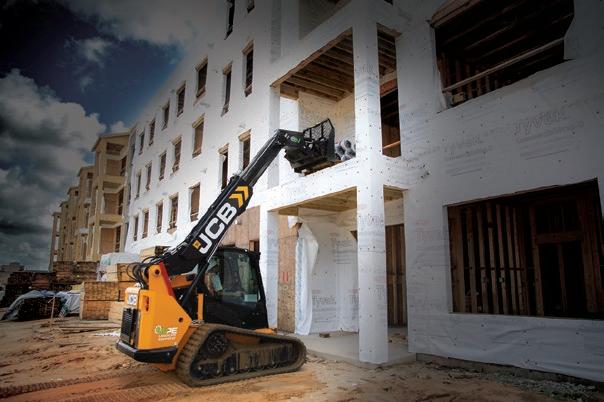
It can reach higher, further and deeper than any other skid steer on the market, and it can access areas you wouldn’t have thought possible.

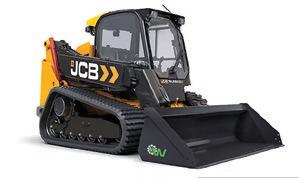

Toro’s all-new lithium-ion battery powered Groundsmaster e3200 out-front rotary mower can be configured with up to 17 HyperCell batteries for all-day runtime in demanding conditions. Battery reserve setting ensures plenty of power to return to the recharging station, with an on-board 3.3kW charger that replenishes the batteries overnight, ready to tackle another day. The e3200 not only eliminates operating emissions for a cleaner environment, but also engine noise for stealthy operation in noise sensitive applications and during early morning operation.

Turf Care Products Canada | Booth 1212 | turfcare.ca

Honda is launching a line-up of battery-powered lawn mowers. The walk-behind HRX, HRN and HRC lawn mowers will deliver the reliability and professional-level performance to match the premium Honda gas-powered models they replace. The all-new ZTR (shown) is aimed at boosting worksite performance in the commercial landscape market, offering an eco-conscious solution with zero emissions and reduced cutting noise.
Honda | Booth 857 | powerequipment.honda.ca









FOUR YEARS AGO, certified landscape designer Fred Post set out on a mission to share his decades of expertise. Today he’s doing just that through an online learning platform. With courses, ebooks and personal coaching, he’s helping new contractors and homeowners navigate their landscape design questions. Balancing his career and passion for mentorship, Fred is committed to helping others thrive in the industry he loves.
In 2020, you decided to find a way to share the knowledge and wisdom you’ve accumulated during your long career in landscape design. Where are you with that mission four years later?
I started landscapingadvisors.ca and connected it to a platform called Teachable, where I offer courses, ebooks and one-on-one coaching. So a client can book a one-on-one session to learn how to do what it is that I do when it comes to 3D designing. I also have ebooks to help young, up-and-coming professionals learn how to build client relationships, boost sales and other key skills. There's so much information — you don't take 40 years of experience and all of a sudden plunk it into just two courses, right? I really started to focus on this in the last couple of years because of a health issue. It puts my life into perspective where I really don't want to go to the grave with all this information that I have.
So I find it very important to try to pass this on, whether it's of monetary value or
not. That's not really the point. The point is to be able to turn two years of learning, for example, into a two-week period. So the Teachable platform itself has really helped me share that knowledge, as well as Facebook groups.
Who is your main audience?
New contractors who are coming out of school and people who want to design and those who want to sell. It always takes a little bit before you get some traction on how to eliminate some of the unknowns, like, how do you defer something that you don't have an answer to? And how do you do small talk? People new in the industry are, first and foremost, who I'm trying to help as much as I can. And then, the flip side is the homeowner. If you go to my website, you'll see one section is for professionals and one is for homeowners. I have so many people who come to me and say, ‘How do I hire a landscaper?’ So I wrote an ebook for the homeowner.
How many people have enrolled in your courses or interacted with the learning content you’ve posted online?
Since I went live, it's been a constant stream; there's probably two to three that come on board every week. We just started advertising because I really wanted to have a full plate of information posted. So we created a whole bunch of courses, videos and tutorials. We've got a whole bunch of ebooks available. I really didn't want to launch it until there was a lot of stuff that people could go to. So I'm pleasantly surprised at the amount of people that are already on board without even advertising.
How do you stay on top of current best practices and trends to ensure what you're sharing is still relevant?
I still work for a boutique firm in Toronto that does some pretty high-end landscape stuff.
I designed for them and I also freelance design for people throughout the States. Every state is unique and by doing freelance, it’s really kind of cool because you see how the midwest is totally different from the south, and the south is totally different from the east. When you have a client base that's all over the place, you get that extra bit of exposure to materials and style trends.
I still travel back to Europe all the time. And I love visiting the gardens out there and seeing what's new because they seem to be the trendsetter.
Do you have any advice for landscaping veterans about mentoring younger generations?
If you have that opportunity and you’ve had a 30- or 40-year career, it's very easy nowadays to come up with a system where you can mentor somebody. Just be a phone call or email away.
And writing an ebook is so convenient. You can still make money off of what you learned, and it doesn't have to go to waste. So if people want to jump on the bandwagon, I would say go for it, because the internet is out there for everybody and it can be a great resource and tool. Even if you don't want to do it for money, then put it out there because it's valuable information.
How does it feel when you see someone thrive after learning from you? Somebody just contacted me last week and they said, ‘Hey, Fred, you taught my daughter last year and she's doing great. It really helped a lot.’ It's nice to hear that kind of stuff where somebody just really excels and shines after they have a one-on-one session or after they do a tutorial. Yeah, it feels great! LT


